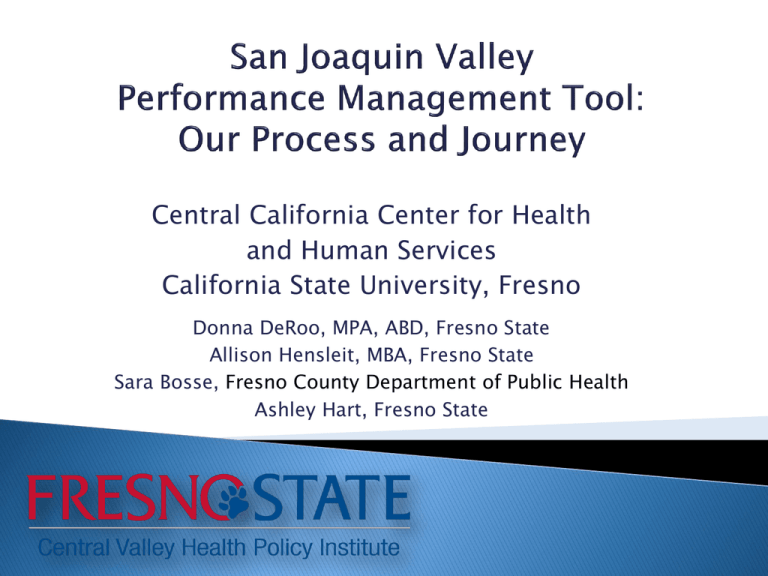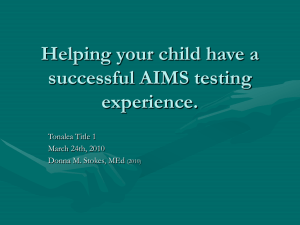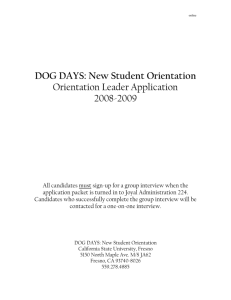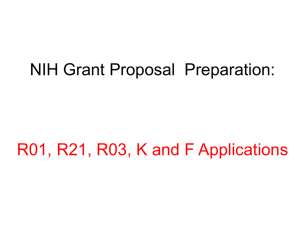San Joaquin Valley Performance Management Tool
advertisement

Central California Center for Health and Human Services California State University, Fresno Donna DeRoo, MPA, ABD, Fresno State Allison Hensleit, MBA, Fresno State Sara Bosse, Fresno County Department of Public Health Ashley Hart, Fresno State San Joaquin Valley Public Health Consortium San Joaquin Valley Public Health Departments Participating Counties: ◦ Fresno, Madera, Merced, San Joaquin, Tulare California Department of Public Health Center for Disease Control and Prevention National Network of Public Health Institutes (NNPHI) Open Forum December 2012 2 Participants will increase their understanding and knowledge of the process and lessons learned in implementing a performance management system. Participants will increase their understanding and knowledge of a performance management system’s utilization as it relates to: ◦ ◦ ◦ ◦ Departments Strategic Plan Community Health Improvement Plan Quality Improvement Plan Public Health Accreditation 3 Attended First Open Forum Charlotte, NC 2013 Fresno County Madera County Merced County [All Divisions] & Tulare County San Joaquin County [2 Divisions] P M 2012 Fresno County San Joaquin County [2 Divisions] QI Fresno County [2 Divisions] & Madera County Merced County [Training] 2014 San Joaquin County Tulare County [All Division] 4 5 Approach Process Performance Management Tool 6 We chose this one … • • • • Robust discussion Team building Highly collaborative Pulse read of activities 1-on-1 Training • Webinars • • Accommodates flexible schedules Remote accessibility • Accommodates flexible schedules Easily accessible Conference Calls 7 Met with Divisions/Sectors/ Programs Met with Senior Leadership • Background & general PMQI overview M1: M2: M3: M4: 1st Meeting 2nd Meeting 3rd Meeting 4th Meeting Met with ALL managers & supervisors • Background & general PMQI overview Performance Management System Tool Delivered! • Draft User Guide • M1: Brainstorm Aims, & Goals • M2: Prioritize Aims, Brainstorm Goals & Performance Measures • M3: Prioritize Goals & Performance Measures, Draft Targets, Timing, Responsibility, Data sources • M4: Presentation of Performance Management System Tool 8 Dept. Mission, Vision, Values Dept. Strategic Aims Division Strategic Aims Division Standards/Goals Division Performance Measures 9 Review overall department aims and how they relate to the division or unit. Articulate how the division or unit contributes to accomplishing department aims. Develop specific aims for the division. Review and adjust aims to reflect accurate assessment of division resources and scope of authority. Dept. Mission, Vision, Values Dept. Strategic Aims Division Strategic Aims Division Standards/Goals Division Performance Measures 10 S.M.A.R.T Specific ◦ Action oriented; providing clear direction; easily understood Measureable Aggressive, but Attainable Results-Oriented Time Bound ◦ Quantifiable and/or verifiable ◦ Challenging and realistic ◦ Focused on outcomes; not methods ◦ Having a reasonable, yet aggressive, time frame 11 Performance measures are the quantitative data elements that let us know: How well we are doing If our processes are functioning efficiently If we are meeting our goals If and where improvements are necessary If our customers are satisfied Capacity Measure Process Measure Outcome Measure 12 A target is the desired end of the year performance outcome which is typically determined by past performance. What needs to be in place before setting targets? ◦ Aim Statements ◦ Goal statements ◦ Performance Measures/Indicators 13 How do I determine what should be the target? Funding Source Sets Target Is this doable? Performance Indicator Organization Sets Target Yes Apply target or set one higher No Set interim targets that bridge the gap Yes Evaluate your history and set benchmark year Do we have the data? Extrapolate to build initial target No Leverage other program targets as starting point Leverage expert input 14 In addition to annual targets, Red Line targets are just as important because they help determine the minimum level of acceptability. Red line targets are unacceptable outcomes at any point and time that require immediate program or organizational attention and intervention. Setting redline targets is essential, and often left out, to help your organization gauge and prioritize your program improvement efforts. Fell on or Short of Red Line Target Performed Above Red Line & Short of Annual Target Red Line Target Achieved or Exceeded Target Annual Target 15 “Kick the tires and light the fires” Implement it – IMMEDIATELY. Allow your teams to become comfortable navigating through the system. Embed the process such that it involves all employees within an organization. Set a date from which all designated performance measure data will be inserted into the performance management system. 16 Performance Management System Division Standards/Goals Division Strategic Aims Dept. Strategic Aim CHIP, CHA Mission Vision Values Quality Improvement Division Performance Measures 17 18 Performance Management System Implementation 19 Cohesive system Increased communication Increased cross-division projects Integration aims, goals, and measures into Department strategic planning Increased accountability More information available for reports and presentations to the Board of Supervisors 20 Leadership & Staff Engagement 21 Complex scheduling coordination Requires more time than LDHs anticipated Right leaders in the room Fear of change Fear of accountability given reduced resources Marathon not a sprint Don’t bite off more than you can chew Strategic plans may need to be refreshed Not for the faint of heart – requires commitment 22 Built community of practice New collaborations Improved internal awareness Potential for maximization of resources Asking the right questions to propel their community impact forward Ownership in the performance management system 23 We would have expanded the implementation timeline to allow the LHDs a month of piloting the performance management tool Basic level of Microsoft Excel experience was much lower than anticipated Underestimated the amount of time required to facilitate the journey from strategic Aims to Performance Measures and Targets Essential to have the groups working together in a room to discuss and collaborate with one another Requires a cultural change from the top down 24 Donna DeRoo, MPA, ABD ◦ dderoo@csufresno.edu; (559) 228-2160 Allison Hensleit, MBA ◦ allison@csufresno.edu; (415) 702-7373 Sara Bosse ◦ sbosse@co.fresno.ca.us; (559) 600-3214 Ashley Hart ◦ ahart@csufresno.edu; (559) 228-2163 26 Appendix 27 28 Term AIM Statement Definition • A clearly articulated aim statement provides both the foundation and the focus of the problem-solving effort. AIM statements answer the question: Example • Increase the means of communication between management and staff • Increase opportunities for staff to work cohesively together as a team. • “What are we trying to achieve?” Performance Standard/Goal • Objective standards or guidelines that are used to assess an organization’s performance. • “What approaches will we utilize to achieve our Aim?” Performance Measure • Quantitative measures of capacities, processes, or outcomes relevant to the assessment of a performance standard/goal. • “What quantitative data do we have available to measure our progress against our goals?” Performance Targets • Specific and measureable goals related to agency or system performance. • “What is he end of year performance we are trying to achieve? • One epidemiologist on staff per 100,000 population served. • 80 percent of all clients who rate health department services as “good” or “excellent.” • Number of trained epidemiologists available to investigate • Percentage of clients who rate health department services as “good” or “excellent.” • Targets may be the same as, exceed, or be an intermediate step toward the measure. 29 30 It’s the New Year and for 2014 you want to live a healthier lifestyle. During your annual physical, your doctor recommends that you lose weight. To determine a reliable indicator of healthy weight, you look at Body Mass Index (BMI) tables and identify the normal weight range for your height. With that standard in mind, you decide to measure weekly weight loss, with a target of losing 2 pounds per week. You also decide to measure caloric intake and physical activity, with a daily target of limiting your calories to 1800 and walking a mile. You monitor your weight weekly using your bathroom scale and report (to yourself!) your weight on a spreadsheet. After tracking weight loss for four weeks, you find that you have only lost an average of one pound per week, so you decide to test an improvement, which involves adding an additional mile of walking per day. Four weeks later, you find that you are meeting your goal of losing an average of two pounds per week. Source: MPHI Office of Accreditation and Quality Improvement 31 When target weight loss was not being met AIM: Live a more healthy lifestyle in 2014. Performance Standard/Goal Reduce BMI to 27 Performance Measure Performance Target Reporting Weight Two lbs per week Recording weight Caloric Intake <1800 calories per day Recording calories 1 mile walk Recording Physical Activity Physical Activity Quality Improvement Test add’l physical activity 32









![slides [ppt, 100kB]](http://s2.studylib.net/store/data/005349567_1-1569ef1d3c36a4731765bd0b9b1f3d88-300x300.png)











